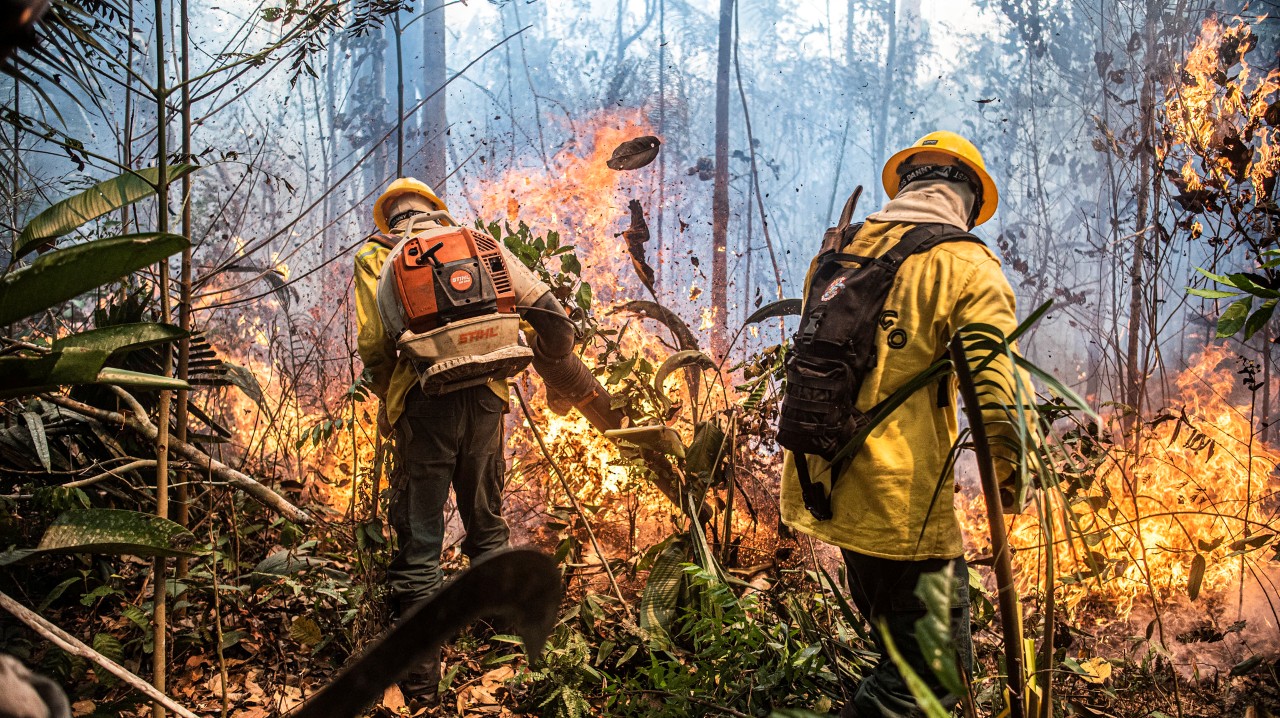Brasil Reduces Wildfires, Adopts Measures to Lead Global Response
The Ministry of the Environment and Climate Change, together with Ibama and ICMBio, strengthens preventive strategies; Brasil reaches lowest number of wildfire outbreaks in the past twelve years

By Mayara Souto / COP30
A record number of firefighters, more equipment, and prescribed burns are among the efforts led by the Brazilian government to prevent and contain forest fires. The fire season in Brasil typically begins in August due to the peak of the dry season. The effects of these measures are already reflected in current data, which show the lowest number of wildfire outbreaks in twelve years in the first months of 2025. This achievement positions the country to lead by example as it prepares to host COP30 in the Amazon — the Brazilian biome most affected by wildfires in 2024, according to the National Institute for Space Research (Inpe).
From January to August 7, 2025, Brasil recorded the lowest number of wildfire outbreaks for this period in the past twelve years — approximately 30,000 incidents. The last time this timeframe saw fewer incidents was in 2013, with 28,000 cases. The data comes from Inpe’s Burned Area Program.
Compared to 2024, the drop in wildfires was most significant in the Pantanal and the Amazon. In the former, incidents fell from approximately 6,600 fire outbreaks in the early months of last year to just 126 in 2025. In the Amazon, the number fell from 30,000 to 7,000 cases.
“Indeed, the number is well below average, and I attribute that to two factors. The first is that last year was completely out of the ordinary. The El Niño effect [which affects rainfall patterns] ended, and we returned to a year with practically neutral conditions. This was coupled with the full implementation of policies stemming from last year’s situation. It was a conjunction of efforts mobilizing local stakeholders, municipal and state governments, with investments in fire departments and an increase in federal-level initiatives, which are also yielding results,” explains André Lima, Special Secretary for Deforestation Control and Environmental Territorial Planning at the Ministry of the Environment and Climate Change (MMA).
According to Inpe, 278,299 forest fire outbreaks were recorded in Brasil in 2024 — a 46.5% increase compared to the previous year. To address this situation, a series of measures were implemented, resulting in positive outcomes in 2025.
“Brasil has been working to lead by example,” emphasized Marina Silva, Minister of the Environment and Climate Change, during a ceremony in July 2025 celebrating one year since the establishment of the National Policy for Integrated Fire Management (PNMIF), one of the measures adopted to strengthen wildfire prevention. She also stressed that progress must continue: “We need to break the inertia of what has already been achieved. Every year, we must surpass ourselves,” she stated.
Efforts
The president of the Brazilian Institute of Environment and Renewable Natural Resources (Ibama), Rodrigo Agostinho, highlighted the importance of the infrastructure gained through federal government initiatives over the past year.
“As much as possible, what we have realized is that we need to reduce our vulnerability, increase our response capacity, and improve our infrastructure. And that is exactly what we are doing. We used the resources from last year’s crisis to strengthen our systems, and this year, we are much better prepared to act — both in terms of prevention and in direct firefighting,” emphasizes Agostinho
Brasil currently has the largest contingent of federal firefighters in its history, with 4,385 professionals — 2,600 from Ibama and 1,785 from the Chico Mendes Institute for Biodiversity Conservation (ICMBio).
This represents a 26% increase compared to 2024. Additionally, seven new helicopters were acquired for Ibama’s use in wildfire and deforestation response efforts, with four more to be added by early August, bringing the total number of aircraft available to the institute to 11. At the same time, over BRL 45 million was invested in operational vehicles between 2023 and 2025, nearly doubling the fleet to 799 units.
Part of the funding used to enhance the structure for forest fire prevention and response comes from the Amazon Fund, which since 2023 has approved BRL 405 million to support the fire departments of the nine states in the Legal Amazon. Of this amount, BRL 370 million has already been contracted. Additionally, for the first time, the fund is also supporting similar initiatives in states outside the Amazon, in the Cerrado and Pantanal regions.
Another important instrument is Brazilian Law no. 15.143/2025, enacted in June, which enhances the capacity to respond to forest fires by allowing direct transfers of funds from the National Environment Fund (FNMA) to states and municipalities. It also ensures more effective deployment of firefighters by reducing the rehiring interval for these professionals to three months. The law further permits the use of foreign aircraft in environmental emergencies.
In September of last year, President Luiz Inácio Lula da Silva also signed Decree no. 12.189, which increases penalties for forest fires in the country.
COP30
Actions specifically focused on Belém, in the state of Pará, are also being carried out in preparation for COP30. As part of prevention efforts, Ibama and ICMBio are implementing two important measures.
“We are creating firebreaks in some areas and conducting prescribed burns in others. This year, we had better and earlier conditions to carry out prevention efforts,” reported João Moreira, environmental analyst at ICMBio.
Controlled burns are widely used to prevent large-scale natural wildfires. In this case, fire is intentionally and carefully set in specific areas of vegetation, creating a natural barrier that helps stop the spread of flames during the dry season. Firebreaks, on the other hand, are strips of land where vegetation is removed to form a kind of “physical barrier” that prevents the propagation of fires.
As for the possibility of containing fires, although November — the month when COP will be held — is not part of the dry season in Brasil, a response plan is currently being developed.
“One state where we already have special attention is Pará. The eastern and southern parts of the territory have been heavily deforested in the past and are areas where fire is present during the driest seasons of the year. So, we are strengthening our teams and taking advantage of the increased number of firefighters,” said the president of Ibama.
João Moreira stated that there are no conservation units very close to Belém under ICMBio’s management that experience recurring fires, which is why other regions are a priority for the agency. “We will support Ibama as needed in the metropolitan area, but our focus will be heavily concentrated on the conservation units along [highway] BR-63, near Itaituba and Santarém,” he added.
Origin
Forest fires are, in part, a reflection of climate change, as André Lima explains: “The world is getting warmer, extreme weather events are increasing in intensity, duration, and frequency, and fires are a consequence of drought periods, which are extreme climate events,” he said.
According to the representative from the Ministry of the Environment and Climate Change (MMA), one of the main contributing factors to this situation is deforestation. “Under normal temperature and pressure conditions, fire does not penetrate a humid forest. The problem is that with climate change, worsening water shortages, and deforestation, the forest becomes more vulnerable. Previously, it acted as a fire suppressor. During the dry season, it becomes fuel,” he warned.
Forests
The president of COP30, André Corrêa do Lago, emphasized in his first letter to the international community the importance of this ecosystem in slowing climate change and its impacts.
“Forests can buy us time in climate action during a window of opportunity that is rapidly closing. If we reverse deforestation and restore what has been lost, we can trigger massive removals of greenhouse gases from the atmosphere while bringing ecosystems back to life. Healthier ecosystems can also offer opportunities for resilience and bioeconomy, supporting local livelihoods, creating sophisticated value chains, and generating innovations in biotechnology,” he wrote.
